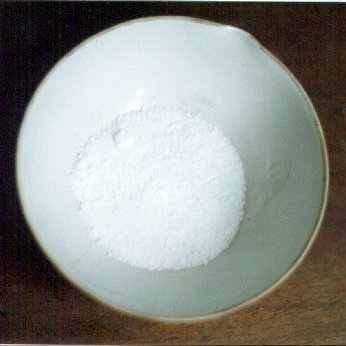Extraction of Plant Salts
Pick at least 5kg of Rosemary (Rosmarinus
Officinalis), or of another plant that you choose and dry it in the sun. After it becomes
very dry, incinerate it on a sheet of iron.
Gather the ashes from the incineration, place
them in an iron frying pan, and set the pan on a gas stove.
Adjust the stove to a very high heat and calcine
the ashes for one hour, constantly stirring them with a stainless steel spoon. When the
ashes are well calcined they will be a clear grey colour.
Next, pour 750 ml of rainwater into a 1 litre
large-mouth flask. While they are still hot, add the ashes to the rainwater, a little at a
time.
It is important that the water level is at least
one hand's-width above the ashes. Add more water if necessary to reach the desired level.
If one flask is not enough to hold all the water, divide the ashes between two or three
flasks as necessary. Stir the water/ash mixture well with a glass rod and then let it
settle for one hour.
If the ashes have been properly calcined, as our
Art demands, the water of the lixiviation will be clear and transparent; otherwise, it
will be the colour of tea.
In another similar flask, place a glass or
plastic funnel with a small cotton lid. Decant the water of lixiviation by pouring it into
the funnel, and when everything has drained, add the ashes to the funnel with a stainless
steel spoon. Rinse the original lixiviation flask with a little rainwater and pour it onto
the ashes in the funnel. When the whole liquid has been drained, pour some more rainwater
on the ashes to extract all of the soluble salt that remains in them.
Pour the lixiviated liquid into a porcelain
container and set it in a sand bath, which has been placed in an electric, or gas oven. As
the water evaporates, the dissolved salt will begin to crystallize or coagulate, and as
the evaporation proceeds further, a film will be created on the surface of the thickening
liquid, which will impede the continued evaporation of the water.
Therefore, when the solution arrives at the point
where it develops a surface film, we recommend stirring it well with a glass rod, to
break-up the superficial layer of coagulated salt.
After all of the water has evaporated, the
remaining coagulated salt should be as white as snow. If it is not white, you will have to
calcine it again in a stainless steel porringer or pan, with a very strong fire and
dissolve it in fresh rainwater once again, following the instructions given above. The
secret to extracting the white salt the first time is the proper and complete calcination
of the ashes. Do not be in a hurry in executing this operation, because if it is done
properly, it will save you a great deal of work.

We met an artist personally whose pretension and
arrogance was humbled to the degree, which characterises true alchemists. On a certain
occasion, we had the opportunity to show him plant salts that were white as snow and
coagulated according to the Art. When we told him that it had been extracted from the
first calcination, he didn't believe it, even though he proclaimed wisdom of the Art and
had never accomplished this on the first crystallization.
When we revealed to him the modus operandi, he
remarked that we burned the sulphur of the salt! It goes without saying that this answer
demonstrates a gross ignorance of the Spagyrical Art.
Although this fixed salt is primarily potassium
carbonate, it also contains small amounts of other mineral salts that were contained in
the plant, and it probably the thick liquid will create contains some oligoelements.
This fixed salt will be necessary, along with the
plant's sulphur or essential oil, in the preparation of the First Being of the same plant.
If you intend to obtain potassium carbonate
(formerly well known as the salt of tartar) exclusively, we recommend incinerating a large
amount of grape-wine tartar, acacia, fern or oak, which are all rich in potassium salts.
If you intend to obtain exclusively, potassium
carbonate or salt of tartar, as it was well known formerly, we recommended to incinerate a
large amount of grape-wine, acacia, fern or oak, which are all rich in potassium salts.
Following the procedure given above, you will
able to extract a beautiful salt of very pure canonical tartar from the crude tartar,
which is commonly left as a residue in wine barrels.
Salt of tartar that has been well calcined, is
highly deliquescent (i.e., it will readily absorb moisture from the air.) Once it has
absorbed some water it's nature is altered, so be sure to store the salt in a well-sealed
large mouth glass flask.
Rubellus Petrinus